TRI Report
By Nena Couch, Beth Kattelman, and Mary Tarantino
Symposia/Events:
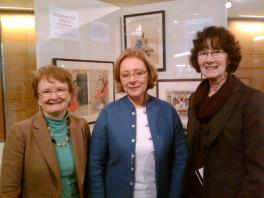
The Lawrence and Lee Theatre Research Institute displayed fifteen woodblock prints by the acclaimed woodblock print artist Tsukioka Kōgyo who produced many spectacular works inspired by the classical Japanese Noh Theatre in the Special Collections Gallery on the main floor of Thompson Library. These prints from the collection of Professors Richard J. and Mae J. Smethurst complemented a lecture by Richard Smethurst, Professor of History at the University of Pittsburgh, on “Tsukioka Kōgyo and the Popularization of Noh, 1869-1927” which the Institute co-hosted with the Department for East Asian Languages and Literatures.
Photo: Japanese Studies Librarian Maureen Donovan, DEALL Professor Shelley Quinn, and Nena Couch with Tsukioka Kōgyo display.
In collaboration with the College of Arts and Sciences Shakespeare Innovation Group, the ongoing initiative with the Royal Shakespeare Company, and timed to take advantage of the RSC Columbus performances of its acclaimed production of Julius Caesar set in contemporary Africa, the Theatre Research Institute displayed materials celebrating Shakespeare and Julius Caesar. At Thompson Library, the Theatre Research Institute and Rare Books and Manuscripts co-sponsored with the Shakespeare Innovation Group a panel including RSC artistic director Gregory Doran, and Ohio State faculty from theatre, classics, English, and African American and African Studies which drew a large audience from multiple departments across campus. Accompanying the panel was an expanded display by the Lawrence and Lee Theatre Research Institute and Rare Books and Manuscripts highlighting the outstanding holdings on Shakespeare in the Libraries’ special collections.
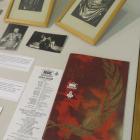
Photo: Portion of TRI materials displayed including program for RSC production in which now-artistic director Gregory Doran played Octavius
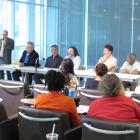
Photo: Panel on Shakespeare and Julius Caesar
In collaboration with the East Asian Studies Center, the Institute for Chinese Studies and the Department for East Asian Languages and Literatures, the Theatre Research Institute sponsored “Hong Shen and the Modern Mediasphere in Republican Era China,” a symposium bringing together Chinese and western scholars on the work and legacy of Chinese dramatist and Ohio State alumnus Hong Shen whose collection has recently been donated to the Theatre Research Institute by his daughter. A selection of items from the collection and additions acquired by the Chinese Studies Librarian were on display during the symposium.
Photo: Display of materials from the Hong Shen Collection in conjunction with “Hong Shen and the Modern Mediasphere in Republican Era China” symposium
Photo: Ohio State doctoral student Man He shares a portion of her dissertation work in her presentation on Hong Shen, ending with a slide combining the original production of Hong’s The Wedded Husband, the first English language play by a Chinese national, premiered at the OSU university chapel in April 1919 before 1,300 people under the auspices of the Cosmopolitan Club, and the 2013 Ohio State revival.
With the Department of Theatre, the Lawrence and Lee Theatre Research Institute co-hosted The First Actresses Symposium which aligned Special Collections with research and curriculum across disciplines including Theatre, and Women’s, Gender and Sexuality Studies, and with programs of the Women’s Place. This program enhanced the Institute’s role as a critical academic partner and as an intellectual crossroads by promoting discourse and fostering interdisciplinary learning. In particular, this symposium highlighted Institute holdings on the Actress in the context of their significance to research with an accompanying exhibit, gallery talk, and commissioned play created from TRI’s Elsie Janis holdings.
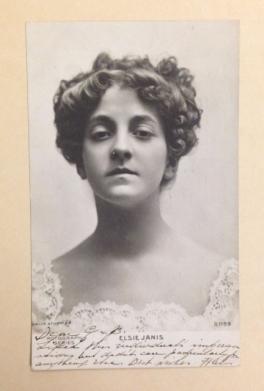
Photo: Elsie Janis
Co-sponsored by the Department of Theatre and the Theatre Research Institute, the 2013 Lawrence and Lee Theatre Research Institute annual lecture was given by Chris Jones, chief theatre critic for the Chicago Tribune. The lecture, “The Last Critic Standing?”, was received with enthusiasm by a crowd of over 65 at the Bowen Theatre in the Drake Performance and Event Center.
Scholarship:
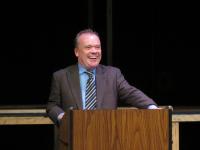
The Theatre Research Institute provided major research assistance to Ohio State students and faculty, and researchers from across the U.S. and foreign countries, independent scholars, non-Ohio State students, theatre practitioners, and producing organizations doing research on diverse topics including actress Elsie Janis, burlesque star Ann Corio, the influence of theatre on the Czech Velvet Revolution, the Dance Notation Bureau, British Dalcroze teachers, burlesque dancers and theatres in the Charles H. McCaghy collection, Kliegl Bros. and technical theatre in the Joel Rubin collection, Porgy and Bess in the Robert Breen Papers, and Uncle Tom’s Cabin in the Harmount collection.
Photo: Lawrence and Lee Lecturer Chris Jones
Several faculty have structured courses to explore special collections in order to give students the experience of working with rare, original, and unique materials, as well as to learn about archival research methods. These courses, which made extensive use of collections and the reading room during 2013 included:
- Louie Ulman’s English 2269, Digital Media Composing, a course which has engaged students with a wide range of special collections, developing multiple projects throughout the term in consultation with curators. For example, the three students working with Theatre Research Institute materials explored Czech scenography, the playwrights Jerome Lawrence and Robert E. Lee and Tom Eyen, the Curtiss Show Print collection, the Jarka Burian Czech theatre collection, and theatre masks, as well as the exhibition curatorial process, TRI exhibitions, the collection acquisition process, and the work of curators, and of undergraduate and graduate student staff.
- In January 2013, the Theatre Research Institute sponsored an exhibition co-curated by members of the fall 2012 Theatre 6701 Research Methods class using TRI collections to explore the issue of Villainy in theatre and film. This exhibition was an outgrowth of several class assignments that build skills in working with primary sources.
- Theatre Research Institute holdings from the Czech theatre and culture holdings, the Eileen Heckart script collection, and the Mircea Marosin design collection for English 1110.01 (First-Year English Composition) which included in-depth one-on-one curator meetings with the students
- Theatre Research Institute theatre graphics materials from across multiple collections for Theatre 5361 (Theatre Graphics I) and two- and three-dimensional scene design work for Theatre 5411 (Scenic Design I)
- Theatre Research Institute Marcel Marceau holdings and curator class presentation for Theatre 6831 (Graduate Advanced Movement)
- Theatre Research Institute and RBMS film scripts for Theatre 5331 (Screenwriting, 2 sections), an ongoing course that was redesigned several years ago through a Course Enhancement Grant collaboration between the TRI curator and Theatre instructor, and is now continued by a second course instructor and curator.
Collections:
The family of Henry Hewes donated his collection to the Theatre Research Institute (where it joins his earlier papers, the American Theatre Critics Association records, and papers of numerous other critics), documenting the career of Hewes as drama critic for the Saturday Review, editor of Best Plays, longtime chair of the Margo Jones Award Committee, one of the founding critics (with TRI donor Clara Hieronymus) of the American Theatre Critics Association, and Theater Hall of Fame inductee.
Dance designs and artwork such as a Charles Maurin portrait of dancer Loie Fuller which complements the Theatre Research Institute Dalcroze collections.
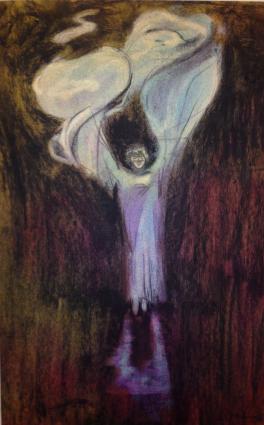
Photo: Charles Maurin portrait of dancer Loie Fuller
Addition to the Carrie Robbins Collection which includes not only her stunning work for theatre but also her work in restaurant design for the Rainbow Room and Windows on the World.
Addition to the Jarka Burian Collection, a collection used in courses in Czech theatre and culture taught in the Department of Theatre and the Department of Slavic and East European Languages and Cultures.
Fred Zint Papers, a newly established collection documenting his parents’ work in tent shows, a popular entertainment of interest to Theatre faculty member Jennifer Schlueter for research and teaching.
Iva Withers Papers, documenting her work as a musical theatre actress during the “Golden Age” of Broadway including Carousel, Oklahoma, and Guys and Dolls (where she overlapped with TRI and Ohio State donor Isabel Bigley Barnett) and on tour in shows, such as Gentlemen Prefer Blondes and South Pacific.
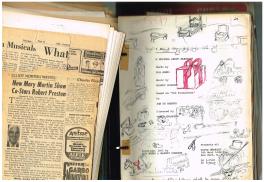
Photo: Materials from the newly acquired Iva Withers Papers
Given by her granddaughter Anthea de Forest, the collection of 19th-century actress Irene de Forest which provides rich resources for both Theatre costume design and popular entertainment curriculum.
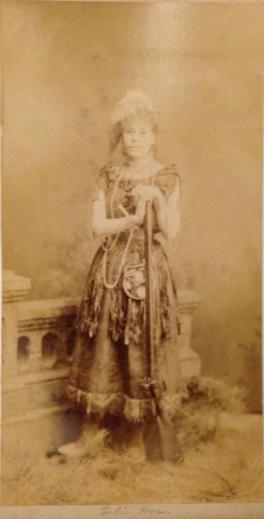
Photo: Actress Irene de Forest as Telie Doe in Nick of the Woods
Photo: Costume made by Irene de Forest
The Dr. Julie “Uberblonde” Vogt’s Archive of the Burlesque Movement, research papers and historical burlesque documents on legendary performer Ann Corio and others which complements the McCaghy Collection of Exotic Dance, used extensively by on- and off-campus researchers.
A significant addition to the Ella Gerber Kasakoff collection left by her as a bequest, documenting her work over decades with Porgy and Bess productions and supplementing the heavily used Robert Breen collection.
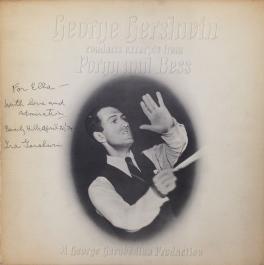
Photo: Autographed album in the Ella Gerber Kasakoff collection
Donor Highlights:
Ohio State Libraries published From Jerry to Jarka—A Breezy Memoir of a Long, Peripatetic Marriage, Grayce Susan Burian’s memorable record of the lives of two remarable people closely tied to Czech artistic, political, and cultural developments over decades. From the mid 1960s through the mid 2000s, Burian and his wife Grayce Susan Burian, also a teacher of theatre, spent extended periods in Czechoslovakia, later the Czech Republic. The Burians arrived in Prague just days after the Soviet Bloc invasion in 1968 and remained during that year. Grayce Burian bears witness to the determination of the Czech people—writing about the student protests, the immolation of Jan Palach, and meetings with dissident artists including Václav Havel that she and Burian experienced. Their research travels also included other European countries and China, enabling Grayce Burian to consider the different communist regimes in which they lived as well as echoes of the Nazi occupation—a Jewish friend remembering her escape from a Nazi camp, a young German struggling to reconcile his heritage, and the Burians themselves staying in Hitler’s private suite in Wrocław, Poland. The Burians were also in Prague immediately following the Velvet Revolution and ideally placed to view the changes, good and bad, in process. And in 2002, they were living in Old Town when the Vltava flooded, devastating large parts of Prague. For more information see http://library.osu.edu/blogs/theatre-research-institute/2013/07/11/from-jerry-to-jarka-a-breezy-memoir-of-a-long-peripatetic-marriage-by-grayce-susan/.
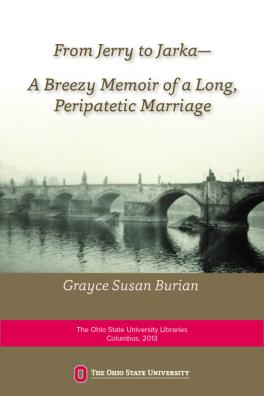
Photo: From Jerry to Jarka by Grayce Susan Burian
Alumnus and designer William Barclay came to visit the Institute in its new Thompson Library location and to review the models he has donated.
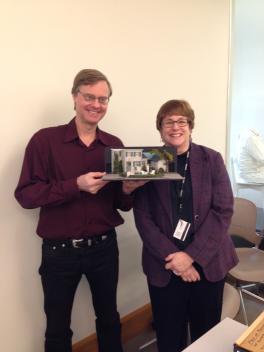
Photo: William Barclay and Beth Kattelman with Bill’s model for All My Sons
Exhibitions:
Three pieces from the Theatre Research Institute were seen by 70,681 visitors to the exhibition Strings Attached: The Living Tradition of Czech Puppets, at the Columbus Museum of Art by the time it ended in August. “Marion Lee,” an almost full-size puppet designed by Petr Matásek for the Department of Theatre’s production aPoetheosis, and now a part of the Institute’s Matásek holdings, remained on display in the lobby of the Columbus Museum of Art by special request for over a month after the Czech puppet exhibition closed.
Participating in OSUL’s exploration of Augmented Reality (AR) technology through implementation in Magic to Do, the January 2014 Thompson Gallery exhibition, theatre alumnus and Theatre Research Institute donor Frank Mohler recorded his voice-over description of the 17th-century theatre technology that was seen by viewers through AR as they looked at the model Mohler constructed from period designs in the TRI microfilm collection.
Photo: Frank Mohler’s Facebook photo and post on the Augmented Reality installation with the model of the 17th-century theatre he constructed.
Virtual Access to Collections:
In addition to cabinet and tobacco cards of 19th-century burlesque dancers in the Charles H. McCaghy Collection of Exotic Dance from Burlesque to Clubs, two additional Institute collections became available in digital form in 2013:
- Pose Plastique Glass Slides, hand-painted glass slides which were used to create a type of tableau vivant ("living picture") performance that was popular in vaudeville at the beginning of the twentieth century. An actress dressed all in white posed against a white background. Then, when a slide was projected onto her, it appeared as if she was in a costume or in a unique environment.
- Twelve TRI scrapbooks compiled at the turn of the twentieth century focusing on the famous actresses of the period.
Photo: Pages from the Sarah Bernhardt scrapbook
All three digital collections are available at http://kb.osu.edu/dspace/handle/1811/47555 .
TRI Fellows funded by the Dance Heritage Coalition project supported by the Council on Library and Information Resources completed their work on September 30, having processed 12 collections (401 linear feet) and created EAD finding aids. All Lawrence and Lee Theatre Research Institute finding aids are available at http://ead.ohiolink.edu/.
